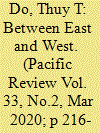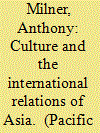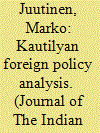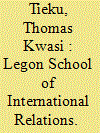|
|
|
Sort Order |
|
|
|
Items / Page
|
|
|
|
|
|
|
| Srl | Item |
| 1 |
ID:
171021


|
|
|
|
|
| Summary/Abstract |
That East Asian IR communities are increasingly interested in knowledge production has become self-evident. While the form that this interest is taken in China is predominantly focused on developing a Chinese School of International Relations Theory (IRT), the situation in Japan is much more diverse and complicated. This article examines the impact of the non-Western IRT movement on Japanese IR academia from a sociology of science perspective. It finds that while indigenous theorizing has garnered interests in a portion of Japanese IR academia due to both internal and external driving forces, there have been few claims for and actual theorizing on a ‘Japanese brand-name’ in IRT like the ‘Chinese School.’ The majority of Japanese IR scholars remain strongly attached to mainstream IRT or the traditional historical and area studies. Such development has its roots in the structural restraints embedded in Japan’s unresolved identity as a de facto polity situated between ‘East and West’ and the heritage of its war-time history. Given these characteristics of IR studies in Japan, the different components of Japanese IR academia will most likely follow their own trajectory without integration and synthesis. This will position Japanese IR, just like its current foreign policy, at a crossroads.
|
|
|
|
|
|
|
|
|
|
|
|
|
|
|
|
| 2 |
ID:
155091


|
|
|
|
|
| Summary/Abstract |
Looking back over the last 30 years, culture as an explanatory factor has been in retreat. Today, however, with the determined reassertion of Islamic values, and an increasingly confident China developing its own international paradigms, the need to investigate cultural and historical specificities is hard to deny. In the Asian region, developments in the South China Sea during 2016 have been especially perplexing for many commentators: International Relations (IR) analysis has come up against a wall of stubborn Chinese and Southeast Asian perspectives. Even some elements in Samuel Huntington ‘civilizations’ approach, widely condemned in the 1990s, today deserve reconsideration – certainly with respect to what Wang Gungwu saw as Huntington's stress on a ‘new language and logic of behaviour’. The common IR analytic framework – highlighting sovereignty, state interests and power (and the balance of power) – needs to be supplemented. Current interest in non-Western IR is promising, especially if it engages in research collaboration with history (particularly the history of ideas, with its focus on close textual analysis). Culture – though certainly in a refined conceptualization – is back.
|
|
|
|
|
|
|
|
|
|
|
|
|
|
|
|
| 3 |
ID:
160251


|
|
|
|
|
| Summary/Abstract |
This article evaluates and interprets Kautilya’s Arthasastra – an ancient Sanskrit treatise on statecraft and foreign policy – as a framework for analyzing the conflicting dynamics in a pluralistic order. Second, it operationalizes Arthasastra as an analysis of Sino-Indian dynamics in South Asia and the Indian Ocean region. In examining Kautilya’s political theory, the article answers the perceived need for non-Western international relations theory. A theoretical contribution of the analysis of Kautilya includes an understanding that even inferior powers can become leaders in international affairs and that the precondition of sustainable leadership is the welfare of all subjects of government. Thus, Kautilya appears as an untapped source for conceptualizing international relations in a post-hegemonic order and provides a normative background for rethinking how to manage conflicts. On an empirical level, the article discusses the problem of China’s membership in the South Asian Association for Regional Cooperation (SAARC), as well as the economic, military and political implications of the Belt and Road Initiative for India and the Indian Ocean Region. The article proposes SAARC + 1, Indian active engagement with the Bangladesh–China–India–Myanmar Economic Corridor and the initiation of investment, connectivity and infrastructure projects through the Quad.
|
|
|
|
|
|
|
|
|
|
|
|
|
|
|
|
| 4 |
ID:
183221


|
|
|
|
|
| Summary/Abstract |
The article explores the Legon School of International Relations (LSIR) which is the research, teaching, and academic programming of International Relations (IR) at the University of Ghana, Legon. The LSIR came out of attempts to decolonise knowledge production, dissemination, and academic programing in Ghana in early 1960s. The article shows that the LSIR is decolonial in theoretical perspective, grounded in southern epistemologies, relational in ontology, qualitative in methodology, practice-based, and it is equity-oriented. Although the LSIR scholarship as a package is distinctive, some of its ideas overlap with the work of several contemporary IR communities in the West. The article highlights implications of the LSIR story for the IR communities in the West and the value of paying close attention to the works of IR centres of scholarship in Africa.
|
|
|
|
|
|
|
|
|
|
|
|
|
|
|
|
|
|
|
|
|